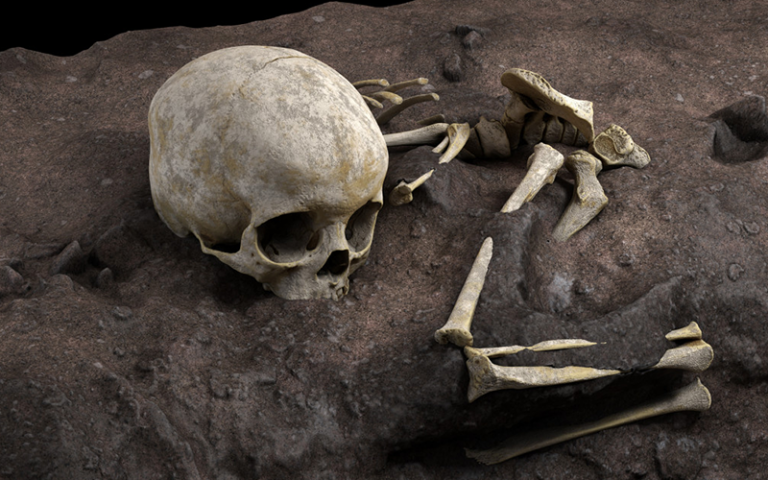The oldest human remains in history are in Africa

The continent of Africa is considered one of the oldest continents in the world, as evidenced by the fact that all the oldest human remains in history that have been found belong to the continent of Africa. The continent of Africa is the cradle of human civilizations, where the oldest human in history lived in its current form (Homo sapiens) on the continent of Africa, and perhaps because of that you know The brown continent is like Africa, so it was necessary for the brown continent to enjoy a better position than it has now.
Oldest human remains:
The oldest human remains in history were found in Morocco in Jebel Irhoud, where skeletal remains were found in Jebel Irhoud in Morocco, and they are about 300 thousand years old. While the age of the oldest human being who lived outside the mother continent reached the age of perhaps when our ancestors in Africa decided to go out and explore and live in other places on earth, as the remains of a human being whose species was not known were found in occupied Palestine, 12 kilometers south of Haifa in the Misliya Cave located on the western slopes of Mt. Carmel. The remains were the left part of the jaw of an adult human who lived 177 thousand to 195 thousand years ago.

Remains of the oldest human in history in Jebel Irhoud, Morocco
The oldest person who lived on the land of Egypt:
Several years ago, human remains dating back 37 thousand years were found.
The discovery of the oldest human being who lived on the land of Egypt. Researchers estimated that the age of this man’s remains dates back to the Stone Age and is more than 35 thousand years old. Thus, the Nazlat Khater human being is considered one of the oldest people who lived on the land of Egypt and one of the oldest human remains that have been found.
Dr. Hussein Abdel Basir, Director of Antiquities at the Alexandria Library Museum, revealed that the ancient Egyptian is 35 thousand years old, when the oldest human remains who lived on the land of Egypt were uncovered in Sohag, specifically in Nazlet Khater.
However, the discovery of the oldest human remains dates back to when work began on the High Dam to generate electricity and protect Egyptian lands from floods, which caused the monuments of Nubia and Aswan to be flooded with water, the most important of which is the Temple of Abu Simbel, which forced the Egyptian authorities to contact UNESCO in order to protect the Temple of Abu Simbel from drowning, and UNESCO took over collecting funds. With Egyptian and foreign hands, the Abu Simbel Temple was moved from its old place where it was built to another place in the interior of the mountain in 1968 AD, due to the fear that the Nubian antiquities would drown under the waters of the dam lake.

It was the beginning of the work of some archaeological missions to uncover the effects of prehistoric times on the banks of the Nile and the Egyptian deserts, and the most important of them was the joint mission for prehistoric antiquities led by the American scientist Dr. Fred Wendorf.
As Dr. Hussein Abdel Basir explained, In exclusive statements to Youm7 newspaper, he said that among the discoveries of the joint mission was the discovery of skeletal remains in the (Wadi al-Kubaniyah) area. Near Aswan, it dates back to about 18 thousand years. Dr. Wendorf's team also discovered the first mass grave near Mount Al-Sahaba in Nubia. The cemetery included the remains of 59 skeletons, dating back to about 13 thousand years.
The Director of the Antiquities of the Library of Alexandria Museum added, “Then the Belgian University of Leuven mission, led by Dr. Pierre Vermersch, began its studies in the region from Qena to Najah Hammadi in Upper Egypt, and in Nazlet Khater in Sohag Governorate in 1980 AD, and a skeleton was found in poor condition and another skeleton in better condition.” In a burial near the quarries in the area, next to it was a stone ax of the type found in the quarries. The skeleton was of a young man, but his spine was suffering from deformities that were mostly due to his work since his youth in the quarries. He was forced to bend over for long periods of time to work in tight spaces.
The Director of the Antiquities of the Library of Alexandria Museum added that this human being is one of the oldest human skeletons discovered in Egypt to date, and reflects the history of the development of human races that lived on the land of Egypt. This was a very important discovery, for two reasons: First, the scarcity of antiquities from this era in Egypt, known as the Upper Stone Age. Secondly, because this period witnessed the emergence of modern humans, and the skeleton of the young man was identified as (Human Nazlat Khater), and his age dates back to 37 thousand years, and “Human Nazlat Khater” is the first Egyptian human whose remains were preserved in the land of Egypt.

A person with a bad mood
The skeleton was left with a mission from the Belgian University of Leuven in 1980 for restoration and scientific studies, and finally the Egyptian Ministry of Antiquities recovered it from Belgium. The skeleton is likely to be displayed in the National Museum of Egyptian Civilization in Fustat, which is considered one of the most famous museums in the world after the 22 royal mummies were transferred to the museum in A majestic procession known internationally as the Royal Mummies Procession.
Source: websites

